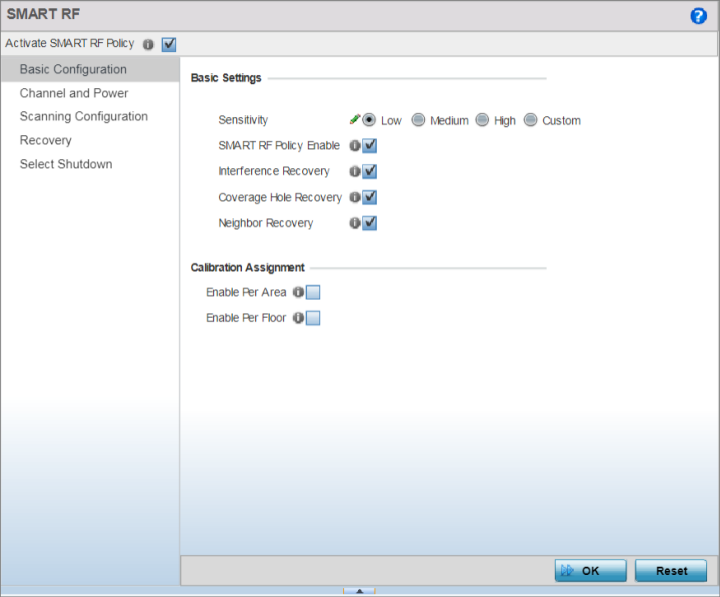Configure Smart RF Basic Settings
To define a Smart RF policy:
-
Select the Activate SMART RF Policy check box to enable
the parameters on the screen for configuration.
The configuration cannot be applied to the access point profile unless this setting is selected and remains enabled.
 SMART RF - Basic Configuration Screen
SMART RF - Basic Configuration Screen
-
Refer to the Basic Settings
field to enable a Smart RF policy and define its sensitivity and detector
status.
Sensitivity Select a radio button corresponding to the desired Smart RF sensitivity. The options include , Medium, High, and Custom. Medium is the default setting. The Custom option allows an administrator to adjust the parameters and thresholds for Interference Recovery, Coverage Hole Recovery, and Neighbor Recovery. Using the Low, Medium (recommended), and High settings still allows these features to be utilized.
Smart RF Policy Enable Select this option to enable Smart RF for immediate inclusion within an RF Domain. Smart RF is enabled by default. Interference Recovery Select this option to enable compensations from neighboring radios when radio interference is detected. When interference is detected, Smart RF first determines the power increase needed based on the signal to noise ratio for a client (as seen by the access point radio). If a client‘s signal to noise value is above the threshold, the transmit power is increased until the signal to noise rate falls below the threshold. This option is enabled by default. Coverage Hole Recovery Select this option to enable coverage compensation from neighboring radios when a radio coverage hole is detected within the Smart RF supported radio coverage area. When a coverage hole is detected, Smart RF first determines the power increase needed based on the signal-to-noise ratio for a client as seen by the access point radio. If a client‘s signal-to-noise value is above the threshold, the transmit power is increased until the signal-to-noise rate falls below the threshold. This option is enabled by default. Neighbor Recovery Select this option to enable Neighbor Recovery when a failed radio is detected within the Smart RF supported radio coverage area. Smart RF can provide automatic recovery by instructing neighboring APs to increase their transmit power to compensate for the coverage loss. Neighbor Recovery is enabled by default when the sensitivity setting is Medium. -
Refer to the Calibration
Assignment field to define whether Smart RF Calibration and radio
grouping is conducted by area or floor.
Both options are disabled by default.
-
Refer to the Smart Sensor field
to set parameters enabling auto-provisioning of APs as sensors.
In a typical WLAN, getting the right balance between the number of APs functioning as sensors and APs providing WLAN service is a serious challenge. The challenge increases exponentially with increase in the size of the deployment. Smart-sensor automates provisioning of APs as sensors without compromising network security.

Note
Currently Smart-sensor is supported only on tri-radio APs. Starting with WiNG 7.3.1, dual-radio APs can also be auto-provisioned as sensors.Enable Smart Sensor Select to enable auto-provisioning of APs as sensors. When enabled, 1/3 of the deployed APs' sensor radios are turned on automatically. Note: This feature is supported on the following APs:- Access points (tri-radio) — AP4xx, AP8533
- Access points (dual-radio) — AP505i, AP510i/e, AP8432
With this enhancement, the following deployment scenarios are possible:- Scenario1: All dual-radio APs deployed: Selected APs will have both radios set to radio-share mode.
- Scenario 2: All tri-radio APs deployed: Selected APs will operate as dedicated sensors.
- Scenario 3: Mixed dual and tri-radio APs
deployed:
- Selected dual-radio APs will operate in radio-share mode.
- Selected tri-radio APs will operate as dedicated sensor.
Note: By default, Smart RF selects and provisions only tri-radio APs as sensors. To enable Smart RF to select dual-radio APs as well, configure the Smart RF policy through the CLI and execute theno > smart-sensor > tri-radio-onlycommand.
Algorithm Cell Size Select this option to enable the use of an algorithmic function to identify the sensor APs. The WiNG Smart-sensor feature uses an algorithm to provision APs as sensor within a site (RF Domain). The algorithm creates a cluster of cells based on inputs from the Smart-RF neighbor table. Each cell in the cluster represents an AP and adjacent cells are the AP's neighbor. The algorithm then identifies APs with best coverage area and provisions them as sensors. However, the algorithmic calculations vary depending on the cell size. The current implementation provides two algorithms based on the cell size (dense/sparse). Select the algorithm best suited for your deployment.- dense - Selects the algorithm best suited for dense deployments. In dense deployments, the cell-size is 'small', with APs deployed close to each other.
- sparse - Selects the algorithm best suited for sparse deployments. In sparse deployments, the cell-size is 'big', with APs deployed far apart from each other.
Note: The Smart-sensor calibration is auto-triggered when Smart-sensor is enabled for the first time. In case a re-calibration is required, you will have to manually issue thetrigger-smart-sensor on <RF-DOMAIN-NAME>command through the CLI to trigger the algorithm. Re-calibration maybe needed if you change the number of APs deployed or the AP deployment pattern within the RF Domain. -
Click OK to update the Smart RF
basic settings for this policy.
Click Reset to revert to the last saved configuration.
